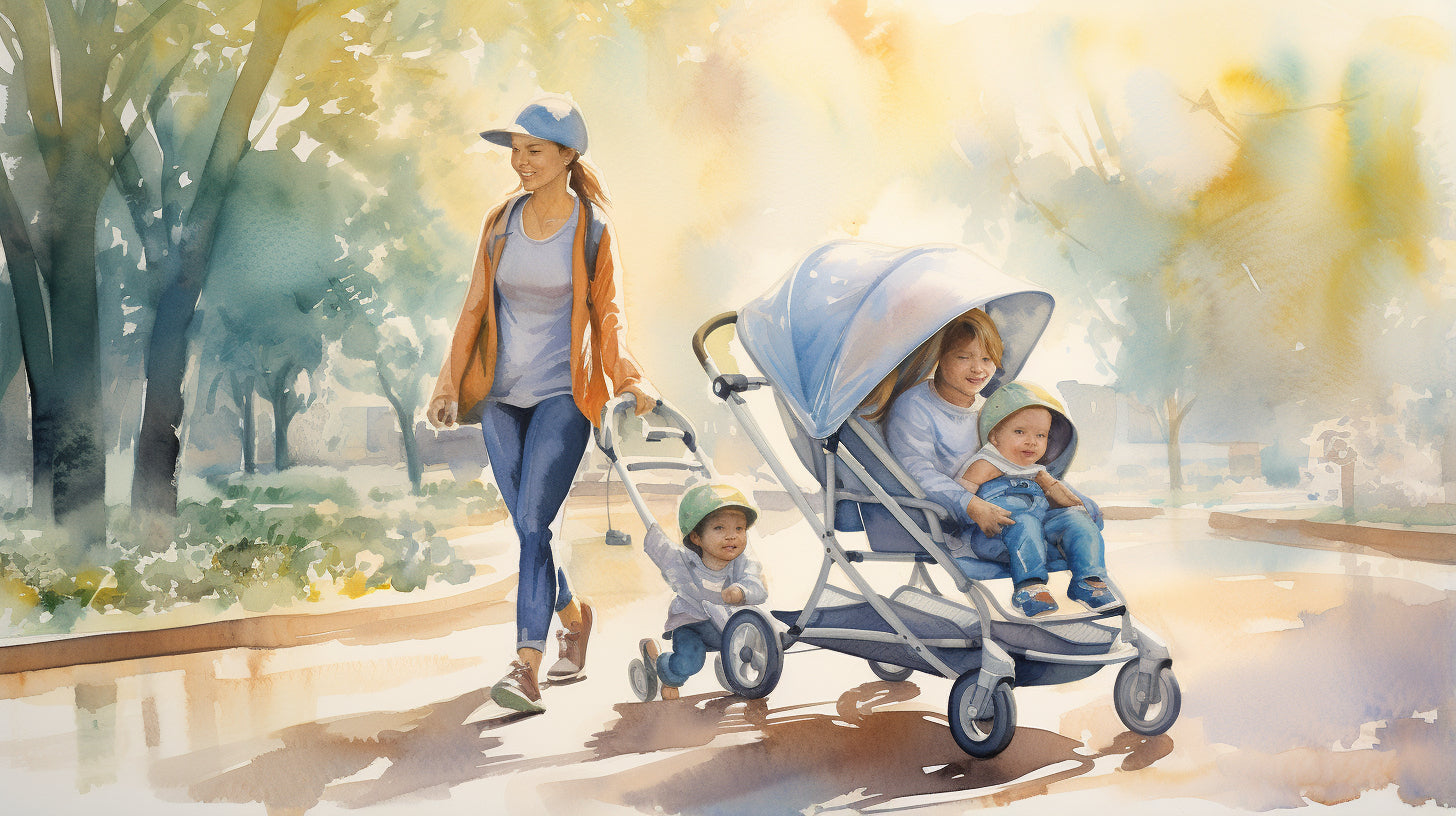In the beautiful world of parenting, staying at home with your children comes with its share of bliss—amidst the neverending rounds of diaper changes, sticky hands, and lovingly chaotic rooms. In such a bustling environment, one central aspect often overlooked is outdoor safety. After all, won't your little ones naturally gravitate towards exploring the great outdoors? Stay-at-home moms, consequently, become the gatekeepers of safety for their kids who are about to venture into this exciting new world right outside the doorstep. This article is devoted to empowering you, the courageous stay-at-home mom, with easy-to-implement tips that maximize outdoor safety for your adventurous young ones. Get ready to create a haven of safe outdoor fun for your children. From maintaining a carefully calculated childcare ratio for safety to planning optimal, sun-safe outdoor activities, we've got you covered!
The Importance of Outdoor Safety
With the sun shining high and the days stretching long, summer becomes the perfect season for outdoor activities. Amid the excitement, however, it's crucial not to sideline the importance of outdoor safety. Neglecting precautions could lead to dire consequences, and it's vital to heed to the saying - ‛prevention is better than cure.'
Statistics bring a sense of realism, so consider this - every summer, over one million children end up visiting emergency rooms due to outdoor injuries. Imagine the worry and distress these families endure, which could have been avoided altogether with some simple precautions!
Here's how you can ensure maximum safety during your outdoor activities:
- Stay Hydrated: This is a no-brainer yet often overlooked. With rising temperatures, it's easy to dehydrate and suffer from symptoms like dizziness and fatigue. Always carry water bottles and take small sips at regular intervals.
- Use Sunscreen: While the sun does feel lovely, its ultraviolet rays can cause burns and even skin cancer. Apply a broad-spectrum SPF 30 (or higher) sunscreen before heading out. Don't forget to reapply every two hours!
- Ensure Proper Gear: Depending on your activity, make sure you have the correct safety equipment. Helmets for biking or skateboarding, life-jackets for boating or swimming, sturdy shoes for hiking, the list goes on.
A quote that puts things in perspective - 'Safety First is Safety Always.' - Charles M. Hayes.
Remember, friends, outdoor fun is great, but your well-being should never take a back seat. By following these tips, you not only ensure your safety but also guarantee a fun-filled time without unnecessary worry hanging overhead!
So next time you plan an outdoor activity, put safety at the top of your checklist. You'll not only have a great time but also prevent any unwelcome surprises. After all, safe is always better than sorry!
Childcare Ratio for Safety
Ensuring safety is a prime commitment in any childcare setting. One aspect that significantly contributes to children's safety is maintaining an optimal staff-child ratio. Having an adequate ratio assists childcare providers in supervising children effectively, thus minimizing incidents and providing a nurturing and safe environment.
So, what is the ideal childcare ratio that accentuates safety? Experts recommend a 1:4 staff-child ratio, especially for outdoor activities. Why is this important, you might ask!
Promotes attentive supervisionMaintaining a 1:4 staff-child ratio enables each staff member to observe and supervise four children effectively. This attentive supervision is particularly important during outdoor activities where children are more likely to engage in physical play and may become prone to accidents.
Ensures immediate responseIn cases of emergencies, a favorable staff-child ratio guarantees swift and immediate responses. With fewer children to think about, caretakers can address an incident promptly, ensuring that an accident doesn't escalate into a more serious issue.
Eases stress on staffWhen staff members are overloaded with too many children to care for, the quality of their supervision may decline, posing potential risk to children's safety. A 1:4 ratio, in contrast, allows the caregivers to perform their duties effectively without feeling overburdened or stressed.
Encourages individual attentionLast but not least, this ratio offers space for individual attention. Each child can receive proper care and assistance, ensuring all their needs are met in a timely manner.
In conclusion, a 1:4 staff-child ratio is not just a random number thrown into the mix. It's a well-thought-out guideline aligned towards providing an optimal environment that balances safety, attention, and care for each child. Embracing this ratio can make a marked difference in the quality and safety of the childcare provided and is hence, a non-negotiable aspect in any childcare environment.
Ensuring Safe Outdoor Play Equipment
When it comes to outdoor play, nothing nurtures a child's physical development and stimulates creativity like a well-equipped playground. Whether it's a swingset in your backyard, a jungle gym in the park, or a multi-play structure in a schoolyard, outdoor play equipment can provide hours of fun and learning. However, to keep these spaces fun and safe, it is critical to ensure that your playground equipment is safe and well-maintained. With a little time and diligence, every caregiver can take preventative measures to minimize potential hazards while maximizing enjoyment for children.
Regular Inspection is Key
Outdoor play equipment should be frequently and thoroughly inspected. Regular inspection helps to identify any wear and tear that could compromise safety. Specific areas to check include:
- Structural integrity: Make sure all equipment is sturdy and firmly anchored. Check for any loose nuts and bolts or splintered, cracked or rotting wood.
- Surfacing: A soft surface can help cushion falls and minimize injuries. Check for any hard, exposed areas or any dangerous debris like broken glass or sharp rocks.
- Swings and slides: Ensure the chains on swings aren't twisted or rusted, and that the seats aren't cracked. For slides, check for any rough edges or loose bolts.
- Other equipment: For other equipment types like seesaws, monkey bars, or climbing structures, check for sturdiness and any sharp edges or corners.
While these are some precautionary measures, it's always wise to teach children safe play habits and supervise them during playtime to further ensure their safety.
Maintain Equipment Regularly
Inspections alone aren't enough. Maintenance is crucial in safeguarding the prolonged usability and safety of outdoor play equipment. Here are some maintenance tips:
- Regularly tighten all bolts and screws: Loose fixtures could make play equipment potentially hazardous.
- Seal wooden equipment to prevent rotting or splintering: Wood rot can weaken structures, while splinters can cause injuries.
- Regular cleaning: Cleaning the equipment helps to avoid buildup of dirt, grime, and allergens, maintaining the hygiene and appeal of the play area.
Ensuring safe outdoor play equipment may seem like a daunting task, but it is an essential part of providing a secure and fun-filled environment for children. With regular inspections and proactive maintenance, you can keep playgrounds exciting and safe, fostering the continued growth and development of our future generations.
Protection from the Sun
Are you worried about the sun's harmful rays? Without a doubt, protecting your skin from the sun should be one of your top health priorities. Fortunately, you can take several plain sailing and practical steps to arm yourself against harmful ultraviolet (UV) radiation. Let's dive into those strategies together, shall we?
Proper Attire
When it comes to sun protection, the right clothing is your first line of defense. Appropriate attire shields your skin from direct exposure to UV rays. It's a good idea to:
- encourage children to wear hats,
- use sunglasses to protect your eyes,
- apply broad-spectrum sunscreen to uncovered areas of skin.
With such measures, with resilience and in high spirits, you can confidently seize the sunny day while remaining shielded from sun damage.
Planning Outdoor Activities
Even the best SPF can't compete with simple planning. Are you aware that UV rays are most potent between 10 am and 4 pm? Making few adjustments in your routine, such as:
- avoiding scheduling outdoor activities during these hours,
- seeking shade when the sun is overhead,
can significantly decrease your UV exposure, keeping those harmful rays at bay.
Sun-Protection Plan for Babies
What about our tiny tots? They have sensitive skin and need special attention. For our little ones, it bodes well to devise a special sun-protection plan. Such a plan could include:
- dressing them in lightweight, long-sleeved clothing,
- using a canopy or sunshade when outdoors,
- applying a gentle, baby-safe sunscreen.
By incorporating these steps, you not only protect your children's delicate skin but also instill in them the habit of sun safety from a young age.
From the right attire to smart planning, and considering the sensitive skin of our offspring, we can certainly outsmart the sun’s harmful rays. No more shall we quake in fear at the blazing ball of fire in the sky. Together, we shall conquer and emerge victorious in our battle against harmful UV rays. So let's greet the sun with a smile every day, knowing we're well-protected!
Important Home Safety Rules
In the grand scheme of things, our homes are our castles. We anticipate serenity, relaxation, and, more importantly, safety within their confines. With common hazards lurking around the corner, the pursuit of home safety becomes paramount. It's not just about having smoke alarms and anti-burglary systems; it's about establishing solid home safety rules that everyone in the household understands and adheres to. Imbuing some of these fundamental home safety rules could save your life, or that of a loved one.
Start by teaching children one of the most crucial rules: do not play with electrical outlets or fire. Kids have a natural interest in exploring and touching things around them. Their curiosity could lead to dangerous situations when it comes to electricity and fire. Here are a few safety rules to implement:
- Cap off all electrical outlets: Children are inclined to stick their fingers or objects into outlets, which could lead to severe injuries. Protect your kids by installing safety plugs or outlet covers in every unused outlet.
- Keep matches and lighters out of reach: Matches, lighters, and other fire starters should be stored in a locked drawer or high cabinet. Make it a habit to check regularly to ensure that these items aren't left within a child's reach.
- Establish boundaries around fireplaces and stoves: If you have a fireplace or stove, set physical boundaries to keep children at a safe distance. This could be in the form of a fire guard or safety fence. It's also essential to explain the potential danger to your kids.
- Educate on alarm sounds: Teach kids what different alarm sounds mean, like the fire alarm or carbon monoxide detector. Show them how to respond in case these alarms go off.
Additionally, remember to always supervise your children, especially during activities that can potentially lead to accidents. Unsupervised children may inadvertently put themselves in harm's way.
Although striking a balance between ensuring home safety rules and not instilling fear in your children might seem like a tightrope walk, it's indeed a necessary task. By practicing these safety rules, we not only safeguard our homes but empower our family members with knowledge that protects them inside and outside our walls. Regularly discussing these rules and reassessing our home's safety measures ensures a safe and harm-free home environment.
Proper Utilization of Equipment
How often do we pay attention to the way we use our everyday equipment? From kitchen tools and gym machinery to office gadgets and construction devices, proper usage is vital not just for purpose fulfillment but also for safety.
When we talk about proper utilization of equipment, it’s a vast subject that includes understanding the function of tools, their handling, maintenance, and above all, the safety measures while using them. Let's delve into the significance of each of these aspects.
Understanding the Purpose
Every tool or equipment comes with a specific purpose, meant to make a particular task easier. Using it for an unintended function can lead to futile results and might even damage the equipment. So, before you put that blender to crush ice or use a regular vacuum cleaner for liquid spills, think again!
Correct Handling
Just knowing the function isn't enough, correctly handling the equipment is equally essential. Right from holding it at an appropriate angle to applying the correct pressure, these small details make a significant impact on the equipment usage outcome. Mishandling can not only lessen the equipment's efficiency but also increase the risk of damage and accidents.
Regular Maintenance
Regular care and maintenance of equipment boost its lifespan and performance. It includes cleaning after use, periodic servicing, replacing worn-out parts, etc. Remember, a well-maintained tool is a long-lasting tool.
Safety Measures
And lastly, but most importantly, safety cannot be compromised at any point. Many accidents occur due to improper handling of equipment, which can be easily avoided by taking necessary safety measures.
To put it in a nutshell:
- Equip yourself with the right knowledge and understanding of your gadgets.
- Ensure it’s rightly handled and well maintained.
- Prioritize safety before everything else.
Following these steps is crucial for the proper utilization of equipment. It can significantly prevent accidents and enhance the efficiency and lifespan of your devices. So next time you use an equipment, remember these points and ensure you're using it the right way.
Personal Safety Precautions
When it comes to navigating our way through life, personal safety precautions should never be an afterthought. Nurturing a culture of safety doesn’t just preserve our health and wellbeing; it also lets us engage with the world more confidently and freely. One vital habit, often overlooked, is always informing someone close to us about our whereabouts—be they a friend, family member, or significant other. Especially if we're venturing to unfamiliar places or embarking on solo trips, having someone aware of our location can truly be a lifeline in an emergency.
Just as crucial is carrying a personal safety device, particularly when stepping out alone during odd hours. These devices can range from protective gear such as pepper spray or a whistle to high-tech gadgets like personal alarm systems, GPS trackers, or even simple smartphone apps. The importance of these cannot be understated:
- Pepper spray: This pocket-friendly device can disarm an attacker, buying you precious time to escape and call for help.
- Whistle: A loud, shrill sound can attract the attention of people nearby, warding off potential threat.
- Personal alarm systems: These devices emit a loud alarm when triggered, not only dissuading attackers but also alerting anyone in proximity to the danger.
- GPS trackers/smartphone apps: With real-time location tracking, these tools can help loved ones or authorities find you quickly should you need assistance.
These precautions, while seemingly fundamental, can greatly reduce our vulnerability to potential dangers and threats. Remember, personal safety isn't about living in fear or paranoia but about empowering ourselves and fostering self-assurance. By keeping safety at the forefront of our minds, we can ensure that we live, travel, and explore the world with the peace of mind we deserve.
Preparations for Outdoor Activities
Engaging in outdoor adventures can make life incredibly enriching. Whether you're biking through forest trails, camping under the starry sky, or merely taking a leisurely evening walk in the park, these ventures offer undeniable charm and countless health benefits. However, getting the most out of your outdoor activities requires appropriate preparation. Two crucial aspects often overlooked are dressing appropriately and ensuring adequate hydration and first aid.
Dressing Appropriately
Selecting the right clothing for your outdoor activities can significantly impact your overall experience. Opting for weather-appropriate attire is paramount, ensuring you stay comfortable and protected regardless of the conditions outside. If you're planning to be active, it might be beneficial to layer your clothes, allowing you to add or remove pieces depending on the weather. For instance, in colder climates, a base layer for insulation, a middle layer for warmth, and a top layer for weather resistance can keep you snug and dry during your adventures.
If you're taking your little ones along, don't forget to dress them in weather-appropriate clothing as well. Babies, in particular, are more sensitive to harsh weather conditions. Comfortable and protective clothing will help keep them safe and comfortable, ensuring they enjoy their time outdoors as much as you do.
Hydration and First Aid
Outdoor activities can be stimulating, filled with excitement and spurts of adrenaline. Nevertheless, they also require a good deal of physical exertion. To maintain your energy levels and avoid dehydration, it's essential to keep a refillable water bottle on hand. Finding fresh and clean drinking water might not always be possible, and a refillable bottle ensures you have your hydration source covered.
Furthermore, even with all the fun and enjoyment that comes with outdoor adventures, minor accidents can happen – tripping and scraping a knee or getting a bug bite, for example. Having a basic first aid kit in your backpack is immensely beneficial. It should include items like bandages, gauze, tweezers, antiseptic wipes, and a topical antibiotic ointment, helping you address small injuries promptly.
Having these simple preparatory measures in place, you can make your outdoor adventures much more enjoyable and memorable. After all, a well-prepared adventurer is a joyful adventurer!
Conclusion
As you navigate the incredible journey of motherhood, remember that adequate outdoor safety measures are not an option, but a necessity. Practice makes perfect; the more you get accustomed to these safety habits, the more they become like second nature, affording you peace of mind while your children explore the world.
As we've discussed in this article, preparation, attention to detail, and personal empowerment are all key to fostering an environment of safety. In the context of personal safety, you might want to explore products such as those offered by Empowered by Ashley. You can find personal safety alarms and unique drink cover scrunchies tailored specifically to augment your confidence and assurance in your daily activities, inside or outside your home.
Your journey toward optimal outdoor safety need not be walked alone. Let Empowered by Ashley accompany you, providing practical solutions and peace of mind. After all, in the quest for safety, every tool, every piece of knowledge, and every handy strategy can make a significant difference. With the right precautions in place, exploring the great outdoors might just become your family's new favorite activity!
Frequently Asked Questions
-
Why is outdoor safety important for stay-at-home moms?
Outdoor safety is important for stay-at-home moms to ensure the well-being of both themselves and their children. It helps prevent accidents, injuries, and potential dangers that may arise while spending time outside.
-
What are some essential outdoor safety tips for stay-at-home moms?
Some essential outdoor safety tips for stay-at-home moms include: 1. Supervise children at all times, 2. Teach your kids about stranger danger, 3. Apply sunscreen and dress appropriately for the weather, 4. Maintain a clean and hazard-free outdoor space, and 5. Be prepared for emergencies by having a first aid kit.
-
How can stay-at-home moms ensure proper supervision of their children outdoors?
Stay-at-home moms can ensure proper supervision of their children outdoors by setting clear boundaries, being engaged and attentive, actively monitoring their activities, and teaching them about potential hazards and safety rules.
-
Why is teaching children about stranger danger important?
Teaching children about stranger danger is important to help them understand the potential risks associated with interacting with individuals they do not know. It empowers them to recognize and respond appropriately to strangers, ultimately enhancing their personal safety.
-
What should stay-at-home moms do to prepare for emergencies outdoors?
Stay-at-home moms should be prepared for emergencies outdoors by having a well-stocked first aid kit, knowing basic first aid procedures, keeping emergency contact numbers handy, and having a plan in place for quick and efficient response to unexpected situations.




















Leave a comment
This site is protected by hCaptcha and the hCaptcha Privacy Policy and Terms of Service apply.